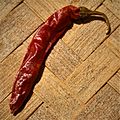Capsicum annuum facts for kids
Quick facts for kids Capsicum annuum |
|
|---|---|
 |
|
| Conservation status | |
| Scientific classification | |
| Genus: |
Capsicum
|
| Species: |
annuum
|
| Varieties and Groups | |
|
|
| Synonyms | |
|
|
Capsicum annuum is a type of plant in the Capsicum family. It comes from southern North America, the Caribbean, and northern South America. This plant is the most common and widely grown of the five types of domesticated peppers.
This species includes many different kinds of peppers. These range from sweet bell peppers to hot chili peppers. Some examples are jalapeños, New Mexico chiles, and cayenne peppers. Wild versions of this plant, like the bird pepper, still grow in warmer parts of the Americas.
Contents
What are the Characteristics of Capsicum Annuum?
Even though the name annuum means 'annual' (which means 'yearly'), this plant is not an annual. It is sensitive to frost. If there are no frosts in winter, the plant can live for several years. It can grow into a large, bushy perennial herb.
The plant's flowers are usually off-white, but sometimes they can be purplish. The stem has many branches and can grow up to 60 cm (24 in) tall. The fruits are peppers that turn green, yellow, orange, or red when they are ripe. Capsicum annuum can grow in most places without frost. However, it grows best in warm and dry climates.
How Does Capsicum Annuum Get Pollinated?
Pepper plants can pollinate themselves. But, when insects visit the flowers, it helps the fruit grow bigger. It also makes the fruit ripen faster and grow evenly. Pepper flowers have sweet spots called nectaries at the bottom of their petals. These nectaries attract pollinators like bees.
The parts of the flower that hold pollen are called anthers. They only release pollen when they are shaken, like by a bumble bee doing 'buzz pollination'.
What are the Uses of Capsicum Annuum?
How is Capsicum Annuum Used in Cooking?
This plant is the source of many popular sweet peppers and hot chiles. People grow them all over the world. It is also used to make common spices. These include cayenne, chile, and paprika powders. It also makes pimiento (pimento).
In English, the names for these peppers often depend on their taste and size. Larger, sweeter types are called "capsicums" in Australia and New Zealand. They are called "peppers" in the United Kingdom and Canada. In the United States, they are known as "bell peppers". Smaller, hotter types are called chiles, chilies, or chili peppers. In some parts of the US, they are just called "peppers."
Special chemicals called capsinoids give C. annuum peppers their unique tastes. One of these chemicals is capsaicin. It creates the burning feeling, or "hotness," that you get from eating hot peppers. This feeling can last for several hours. The Scoville scale was created to measure how hot peppers and other foods are.
How is Capsicum Annuum Used in Traditional Medicine?
Hot peppers are used in traditional medicine in Africa, as well as in food. A British botanist named John Lindley wrote about C. annuum in his book Flora Medica in 1838. He said it was used with Cinchona for certain illnesses. These included problems like gout, indigestion, and paralysis. He also noted its use in treating severe sore throats and Scarlet fever.
In Ayurveda, an ancient Indian medicine system, C. annuum is described in a special way:
- Guna (properties) – ruksha (dry), laghu (light), and tikshna (sharp)
- Rasa (taste) – katu (pungent or spicy)
- Virya (potency) – ushna (hot)
Are There Ornamental Capsicum Annuum Plants?
Yes, some types of Capsicum annuum are grown just because they look pretty. Examples include the 'Black Pearl' and the 'Bolivian Rainbow'. These ornamental types often have unusually colored fruits and leaves. Colors like black and purple are common. All of these ornamental peppers are safe to eat, and most of them, like 'Royal Black', are hot.
What Pests Affect Capsicum Annuum?
The potato tuber moth (Phthorimaea operculella) is an insect that likes to eat plants from the Solanaceae family, which includes pepper plants. Female moths lay their eggs on the leaves. When the larvae hatch, they eat the inside of the leaf.
Images for kids
-
Dried Guajillo chile pod
See also
 In Spanish: Pimiento morrón para niños
In Spanish: Pimiento morrón para niños


















